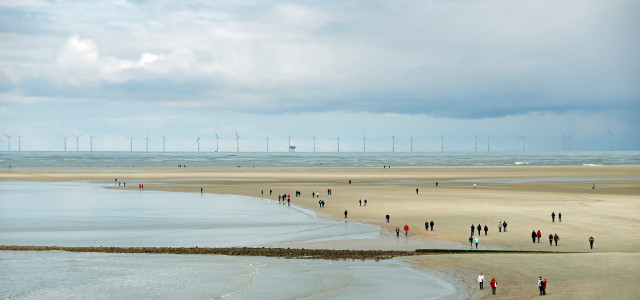In the first half of 2015, more offshore wind power capacity was added in Germany than the country previously had. The government is reportedly considering raising its target for 2020. Craig Morris explains.

Germany already has a total of 668 offshore wind turbines. (Photo by eLKayPics, CC BY-NC-ND 2.0)
In the first six months of 2015, 1.77 gigawatts of new offshore wind capacity was connected to the grid in German waters according to the Offshore Wind Energy Foundation. At the beginning of the year, the country had just barely crossed the one gigawatt threshold, so the total is now 2.78 gigawatts. An additional nearly 500 megawatts is expected to be added in the second half of 2015, so Germany should have around 3.3 gigawatts connected to the grid by the end of 2015. As of 30 June 2015, 668 turbines had been built offshore, putting the average unit size at 4.15 megawatts.

A map of German offshore wind farms in the North Sea and the Baltic. Source: Offshore Wind Energy Foundation.
An additional roughly 2.1 gigawatts is in the pipeline for a couple of years, which would bring the total up to around 5.4 gigawatts in the next few years. Germany has a target of 6.5 gigawatts of offshore wind by 2020, so that target now seems easily reachable. It was originally set, however, at 10 gigawatts but revised last year when the Renewable Energy Act was amended.
The sector itself says that 2016 will be a crucial year because the design of future tenders will take shape. The transition away from feed-in tariffs to tendering (also known as “requests for proposals” in North America) is unlikely to hamper offshore wind projects, which are relatively few in number and already quite large.
According to German economics weekly Wirtschaftswoche (report in German), top government officials are now considering increasing the target to 7.7 gigawatts by 2020 in order to avoid an artificial market slowdown. The announcement is interesting because insiders have told me that the Energy Ministry is skeptical of offshore wind because it is so expensive compared with onshore wind. Now, it seems that some officials are pleased that the first two German offshore wind farms – Alpha Ventus and Baltic 1 – have performed better than expected, specifically producing more electricity than hoped for.
The big question is whether prices will be brought down. Under current feed-in tariffs, offshore wind farms receive either 15.4 cents per kilowatt-hour for the first 12 years or 19.4 cents for the first eight years. After that, they receive 3.9 cents. In a simple equation, the initial 15.4 cent option followed by 3.9 cents turns out to be worth 10.8 cents on average, compared to 10.1 cents for the 19.4 cent initial offer.
In other words, offshore wind power costs around 10-11 cents in Germany, compared to between 6-8 for onshore wind. Better-than-expected power production also means unexpectedly high returns, so the feed-in tariffs for offshore wind clearly could be brought down.
The point is debatable if auctions replace feed-in tariffs, as planned. However, auctions produced higher prices in the pilot round for photovoltaics. In auctions, bidders propose their own prices. Because only a small number of firms do business at all in the offshore wind sector, competition is more limited than with onshore wind. If the bids are even higher than current feed-in tariffs, the firms will be making a pretty penny – at a time when the government promised to clamp down on the cost of the Energiewende.
Craig Morris (@PPchef) is the lead author of German Energy Transition. He directs Petite Planète and writes every workday for Renewables International.